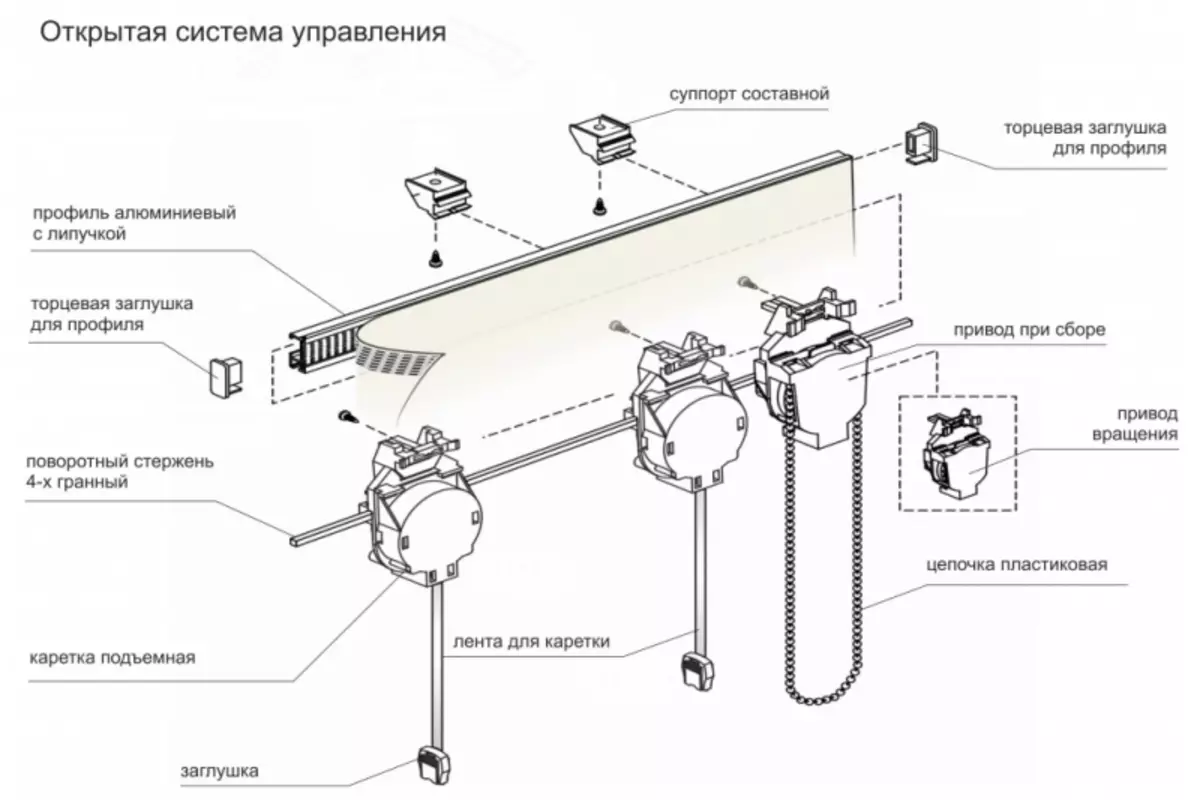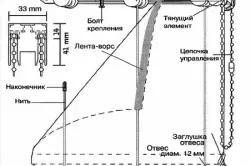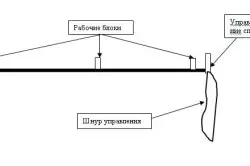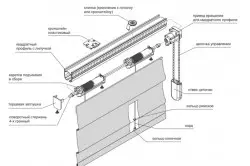Sew Roman curtains do it yourself - not a problem. It is much more difficult for them to make independently eaves. Antique curtains - the semblance of sails, because they appeared on the light due to navigators. Roman curtains in their simplicity resemble sailing panels, their lifting mechanism is also very similar. They will easily fit into any style of apartments, houses, non-residential premises. Purchase the finished cornice - the pleasure is quite expensive. But, if you gain patience, you can create it yourself. The rules for the manufacture of the eaves are quite simple and understood even beginners in home-made art.

Correspondure scheme for Roman curtains with an open control system.
The system has not changed with deep antiquity?
And it really is so, because all ingenious is simple.
Eaves for Roman curtains today are made in the same way as before our era.
The age of Roman curtains is several thousand years. Materials change, new styles, fashion trends, flows, but the Roman curtains remain unchanged, like the eternal city on seven hills, where all the roads are. Immediately it should be noted: the popular element of the decor of the room is established depending on not from designer addictions, but from where it will be as functional as possible. Roman curtains can be attached directly on the window profile, they will be very tightly fit for it. The sound is placed inside the window opening. Roman curtains are fixed outside the window opening, fixing on top slope. The ceiling is an excellent option to arrange the slope, the one is fixed from the outside of the window opening.

The scheme of the device of the Roman cornice.
To figure out how to make cornice for Roman curtains, it is necessary to analyze the specifics of its design. The curtains themselves consist of a rectangular cutting of the fabric, which in its area is greater than the decorated window. The texture of the fabric may be the most diverse in density, color and pattern, the main thing is that it is harmoniously fit into the aesthetic space of the room. Raised Roman curtains look aesthetically, because in this form they form neat folds. This happens, because the planks from the wrong side do not give fabrics the possibility to sign, and the ropes in the rings are collecting a chart. Fixing fabric is performed by clamps.
Article on the topic: How to attach velcro to the eternity: Popular ideas
It is noteworthy: Roman curtains are really installed without a cornice element. What are the advantages of the Roman curtains with him without it - a controversial question, which is solved on the basis of the features of the interior of the room, window openings and the desires to maximize the functionality of the space. The fastening of the Roman curtains infaneless method has its own nuances. The canvas is fixed on the mounting board, Bruke, which still need to consolidate. A common mistake of those who are solved on such an operation is a construction stapler. He will fasten the chart, of course, reliably. But then how to remove it without damaging the fabric? Roman curtains are infant with screws and with screws. They are tightened through the velocked holes in the tissue. You can buy more special clips or railing. The latter works independently of the presence or absence of a cornice. Specialists in the design of the interior to work with the curtains still use a special sticky tape, however, as practice shows, the presence of cornice for Roman curtains is the most optimal, practical option.

Scheme of the lifting mechanism for Roman curtains.
When choosing a place where Roman curtains are installed, proceed from the functionality.
They can be installed:
- Very tight to the window, directly on the window frame itself;
- inside;
- Outside, right on its top slope;
- Outside open windows, straight to the ceiling.
On the variants of the mechanism and its choice
There are various mechanisms among the Roman curtains, the most common are considered a cord, rotary-chain, motorized. The first simplest, it is easiest to make it yourself. The cornice looks like a cord system by which Roman curtains rise and fall. The cord mechanism will not be difficult to fix or replace one or another item in it. However, he has a weak side. For heavy Roman curtains, it will not suit, as the fabric, weighing from 4 or more kg, and such a velocity system can not be combined. In this case, it is better to choose a rotary chain mechanism. It is much more complicated to make it. At the heart of the system of raising and lowering the curtains - chain control, when with the help of the chain, it is impact on the block, it, in turn, leads to the movement of the tape, which is fixed on the canvas.
Article on the topic: Waves in a gazebo with their own hands: Designing from plywood
Cord and rotary-chain mechanisms are very similar, but the eaves, where the second is applied is capable of performing actions with tissues weighing up to 7 kg. Motorized cornice is the most modern mechanism for raising and lowering the Roman curtains. The remote control manages the entire process.

Correspondure circuit with a closed control system.
Such a corze is designed for the canvas of any weight and size. It is not a problem for him if the window opening is at high altitude or in a hard-to-reach place. Make a motorized eaves under the power of this craftsman, especially since the installation of the mechanism will require significant efforts.
In order to choose the right mechanism for the Karnisa of the Roman Curtain, it is necessary to consider a few more points. The cost of making a rotary chain mechanism will be higher than cord. When choosing a cornice, it is necessary to take into account the weight of the curtains itself. For nonsense curtains optimally make a cornice with a cord system. It is perfect for the installation of the curtains on the window sash, the window frame. The last mechanism is particularly convenient in small rooms and urban small-sized apartments, because it will not require a lot of space, and as a result of its application, the room will begin to look neatly, well maintained, elegantly.
Laces, Velcro and what else?
How easy and quickly make a mechanism for the Roman curtains? First you need to purchase a ring for him. How many will they need? We consider the number of horizontal folds, we multiply on 3 and get the desired amount of rings. Upper fixation ears Roman curtains usually require no more than 4 pieces.
We still need cords and textile velcro. For one curtains, three equal cord will be required. Calculate the length of the segments will not be difficult: the height of the canvas is multiplied by 2, and the allowances for nodes are added, which will be located on all rings.
Initially sewls. The distance between them should be the same. The operation is performed on the inside of the web. The rings are fixed on the textile tape. Textile velcro will play two roles simultaneously. Its rigid part, fixed on the bar, will perform the function of the eaves, and the soft - facing the involving side of the canvas - to its upper edge. As soon as the canvas is attached to the eaves, it turns his face down to attach the ears. Three of them are located opposite the rings of the rings, one more thing - where the cords are displayed, that is, with the side of the canvas.
Article on the topic: How to independently sew a beautiful tulle on the windows
The cords pass through the rings. This operation begins with the bottom of the curtains. On all rings, nodes are made, but on the ears - no. There you can only stretch the cords, more precisely - their bunch. If it is held in the fourth ear, the system is ready for operation. However, it is necessary to remember the next stage of operation: fixing the curtains on the window opening. For this operation, it is best to use a metal bracket.
